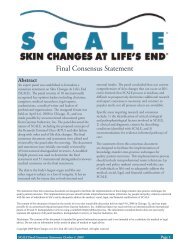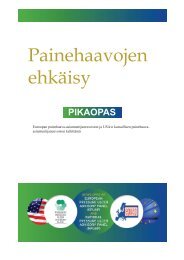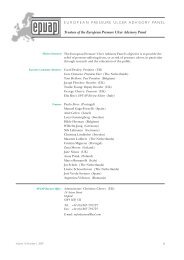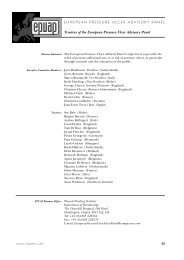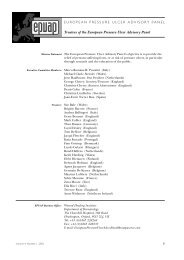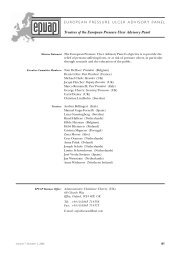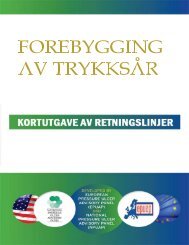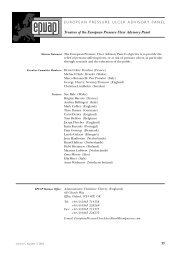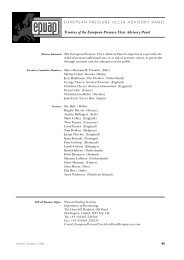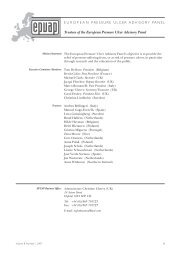Review 6.2 - European Pressure Ulcer Advisory Panel
Review 6.2 - European Pressure Ulcer Advisory Panel
Review 6.2 - European Pressure Ulcer Advisory Panel
Create successful ePaper yourself
Turn your PDF publications into a flip-book with our unique Google optimized e-Paper software.
ABSTRACTS FROM THE 2ND WUWHS MEETING<br />
the presence of blanchable erythema or non-blanchable<br />
erythema. To distinguish between blanchable and nonblanchable<br />
erythema, both thumb and transparent disk<br />
were used. The researcher executed the same observations,<br />
independently.<br />
Results: The interrater reliability between nurse and researcher<br />
was both for the thumb method (k = 0.67) and<br />
transparent disk (k = 0.70) substantial. The agreement was<br />
higher for the sacrum than for the heels. The agreement<br />
between the observations with thumb and transparent disk<br />
was high, both at nurses (k = 0.88) and researcher (k = 0.88),<br />
however, more non-blanchable erythema was observed with<br />
the transparent disk. The agreement was higher for the<br />
heels, than for the sacrum.<br />
Discussion: The interrater reliability was higher for the<br />
sacrum than for the heels. When using a transparent disk<br />
more non-blanchable erythema was identified.<br />
PRESSURE ULCER PREVALENCE: USING<br />
EUROPEAN METHODOLOGY IN THE IRISH<br />
HEALTH CARE SETTING<br />
J. O’Brien, Z. Moore<br />
Background: <strong>Pressure</strong> ulcers are common however, in Ireland<br />
there are no national prevalence figures available and<br />
no national guidelines exist for pressure ulcer prevention<br />
and management.<br />
Aims: 1) To gain insight into the use of the EPUAP pressure<br />
ulcer minimum data set. 2) To establish pressure ulcer prevalence<br />
and risk status of the population in an acute hospital<br />
setting. 3) To identify the number and severity of pressure<br />
ulcers and prevention strategies in use.<br />
Methods: A survey was conducted using the EPUAP pressure<br />
ulcer minimum data set. Permission to conduct the study<br />
was granted from the Director of Nursing Services and ethical<br />
principles were adhered to. The study site was chosen<br />
using random sampling and all patients were assessed (n =<br />
519). Data analysis was carried out utilising SPSS version 11<br />
Results: <strong>Pressure</strong> ulcer prevalence was 15%. Most patients<br />
were in the acute care/high dependency care setting (63%)<br />
and 20% were at risk of pressure ulcer development ranging<br />
from low high (Braden Scale). 78 pressure ulcers were<br />
identified and 57(73%)were grade 1 or 2 damage (EPUAP<br />
grading). A range of prevention measures was used, the<br />
appropriateness of these varied among the risk groups.<br />
Discussion and Conclusion: This study provides a clearer understanding<br />
of the scale, nature and severity of the problem<br />
of pressure ulceration. Based on this information plans<br />
can be drawn regarding appropriate resource allocation and<br />
future research within the Irish population.<br />
SEVERITY, LOCATION, DURATION AND<br />
ORIGIN OF PRESSURE ULCER WOUNDS IN<br />
GERMANY<br />
N. Lahmann, T. Dassen<br />
Introduction: Data about the severity, location, duration and<br />
origin of pressure ulcer wounds in German Healthcare facilities<br />
are rare. Knowledge of these characteristics could<br />
be used to evaluate the preventive and therapeutic pressure<br />
ulcer management, i.e. long duration of pressure ulcer<br />
wounds may open the way for a discussion about the<br />
necessity of improved or new treatment procedures. In the<br />
years 2002 and 2003, the ‘Department of Nursing Science’<br />
at the Humboldt-Universität zu Berlin conducted nationwide<br />
surveys on the prevalence of pressure ulcers in German<br />
hospitals and nursing homes, during which data about<br />
the severity, location, duration and origin of pressure ulcer<br />
wounds were obtained. The research question is: What are<br />
the differences of pressure ulcer wound characteristics between<br />
nursing homes and hospitals in Germany<br />
Method: The study design consisted of two point prevalence<br />
studies conducted in April 2002 and April 2003. Specially<br />
trained ward nurses examined all hospital patients and<br />
nursing homes residents who were able to give informed<br />
consent. Where a pressure ulcer wound was diagnosed, the<br />
severity, origin, duration and location had to be stated. Demographic<br />
data and a risk assessment according to the<br />
Braden scale were obtained. Chisquare was used to test for<br />
statistically significant differences.<br />
Results: 2158 out of 21,574 hospital patients and nursing<br />
home residents had a total of 3,857 pressure ulcers. <br />
In hospitals 36.4% of these wounds were of severity grade 2<br />
and higher; in nursing homes the percentage of these<br />
wounds was 46.7%. In hospitals 51.4% of all wounds<br />
were developed nosocomially compared to 60.2% in nursing<br />
homes. In hospitals 7.4 % of all wounds have<br />
persisted for more than three months, 29.7% in nursing<br />
homes In both types of institutions they were most<br />
commonly located on the lower back area and the heels.<br />
Summary: In Germany pressure ulcer wounds in nursing<br />
homes are more severe, persist longer and more often develop<br />
nosocomially in nursing homes than in hospitals.<br />
URBAN AND RURAL USA NURSES’<br />
KNOWLEDGE OF PRESSURE<br />
E.A. Ayello, FAAN, K. Zulkowski, ONS, RN, CWS<br />
Introduction: <strong>Pressure</strong> ulcers continue to be an important<br />
issue for nursing home residents in the United States.<br />
Documentations and treatment of pressure ulcers are critical<br />
components in the provision of optimal care, in this<br />
population. In long term care (LTC) facilities, it is the staff<br />
nurses that must understand how to assess risk for pressure<br />
ulcers that have developed, and implement prevention/<br />
treatment programmes. The knowledge level of nurses employed<br />
in long term care facilities has not been examined.<br />
Nurses in rural areas may have fewer opportunities for continuing<br />
education programmes than their urban counterparts.<br />
It is not known if there is a difference in pressure<br />
ulcer knowledge by geographic location.<br />
Methods: Nurses employed in LTC both urban and rural settings<br />
have been invited to participate in the study by completing<br />
a standardized pressure ulcer knowledge tool developed<br />
by Pieper and a demographic sheet developed by<br />
the authors.<br />
Results: Data is being analysed using SPSS 11.5 statistical software.<br />
Data collection is in progress with over 700 surveys<br />
mailed. The presentation will give the results of both urban<br />
and rural nurses knowledge of pressure ulcer identification,<br />
risk and treatment using a standardized pressure<br />
ulcer tool developed by Pieper.<br />
Volume 6, Number 2, 2004 49



